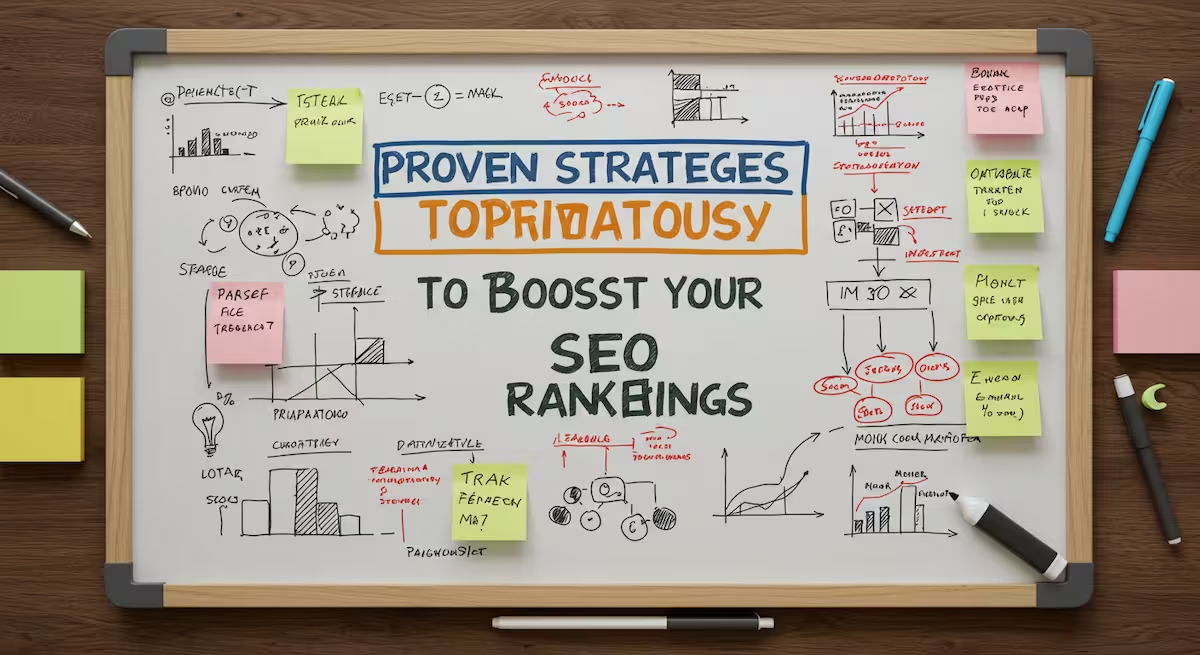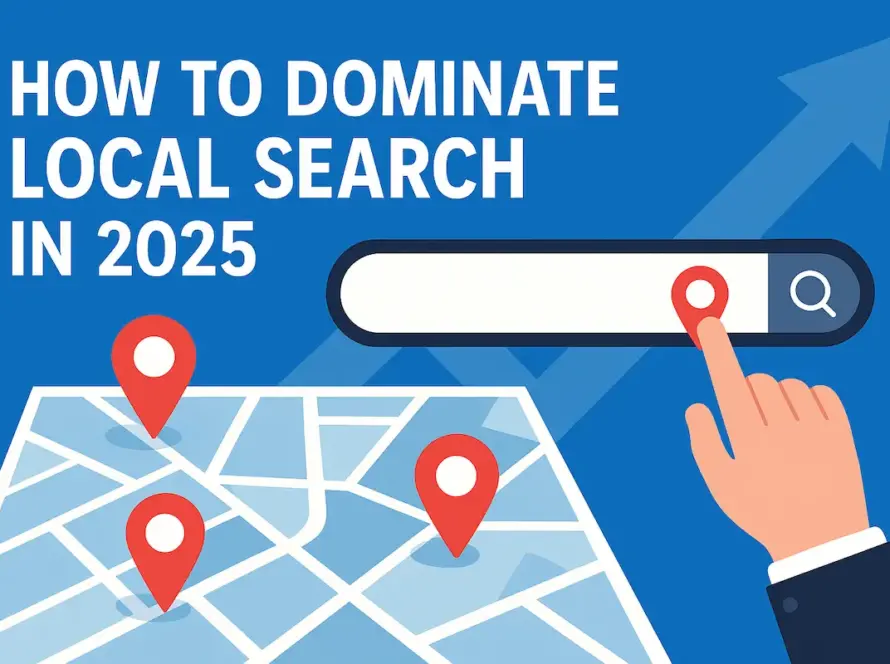Struggling to Get Seen Online?
You’ve spent hours creating content you’re proud of. Maybe it’s a helpful blog post, a detailed guide, or a product page you know could really help people. But when you search for it on Google, it’s nowhere to be found, often buried on page 3 where no one ever looks.
That’s frustrating, and you’re not alone. Studies show that less than 1% of people click anything beyond the first page of Google. In other words, if you’re not showing up near the top, your chances of being discovered drop fast.
The encouraging part is that SEO rankings aren’t permanent. With the right steps, you can move your website higher and get in front of the people who need what you’re offering. That’s exactly what we’ll break down here, step by step.
What SEO Rankings Really Mean
Think of Google as the world’s biggest librarian. Every time someone searches for something, that librarian runs off to find the best “book” that answers the question. Your website is one of those books.
If your “book” is sitting on the bottom shelf in a dark corner, almost nobody is going to see it. But if it’s placed right at eye level on the first shelf, people will grab it immediately. That’s what ranking higher on Google does: it puts your content where people can actually find it.
And while there are other search engines out there, Google is where most of your traffic will come from. Improving your SEO rankings is about showing Google that your “book” deserves a spot on that first shelf.
Why Your Current SEO Strategy Might Be Failing
If you’ve been trying SEO for a while but still aren’t seeing results, you’re not alone. Many business owners and marketers feel like they’re doing “all the right things,” yet their rankings never seem to move. The truth is, SEO in 2025 looks very different from what it did even a couple of years ago.
Google keeps updating its algorithms, and that means old tricks don’t work anymore. Tactics like keyword stuffing, buying cheap backlinks, or publishing thin content used to get sites ranking fast. Today, those same moves can actually hurt you instead of helping.
The biggest change has been Google’s focus on user experience. It’s no longer enough to just have the right keywords scattered across your site. Google wants to see that people actually enjoy using your website. It should load quickly, be easy to navigate, and give readers real value. If visitors leave within seconds, that signals to Google that your content isn’t doing the job.
The fundamentals of SEO still matter. Things like solid keyword research, quality content, and clean site structure remain the foundation. The difference is that you now need to do them with your audience in mind, not just search engines. That’s where real results come from.
Improving your rankings might feel like climbing a mountain, but it’s really about taking steady steps in the right direction. Think of these seven pillars as the base you need to build a strong, lasting SEO strategy.
The 7 Pillars of SEO Success in 2025
Pillar 1: Create Content That Delivers Value
Forget about writing to impress Google’s robots. Write for real people. If your content doesn’t answer a question, solve a problem, or add value, readers won’t stick around. A simple way to test this is the “pizza test.” Would you rather read a bland, lifeless article about pizza or one that makes your mouth water and actually tells you which toppings go best together?
Focus on what people are truly searching for. Are they looking for step-by-step guides, comparisons, or quick answers? Keep your content detailed enough to be useful, and cut the fluff. Update old posts regularly too, since refreshing them with new stats, examples, or tips can bring surprising traffic gains.
Practical tip: After writing each paragraph, ask yourself, “So what?” If it doesn’t serve the reader, cut it.
Pillar 2: Strengthen On-Page SEO Essentials
This is where easy wins come in. Small tweaks can make a big difference. Start with your title tags. They should be clear, clickable, and naturally include your main keyword. Think of your meta description as a movie trailer: short, engaging, and designed to make people curious enough to click.
Use headers (H1, H2, H3) to organize your content logically. Keep URLs short and simple. Link internally between related pages so Google and readers can easily follow your content trail.
Practical tip: Use the 5-second rule. If someone lands on your page, can they tell what it’s about within five seconds? If not, simplify.
Pillar 3: Address Technical SEO Issues
Technical SEO can sound scary, but most of it comes down to common sense. Make sure your site works well on mobile because most visitors are coming from their phones. Speed matters too. If your page takes forever to load, people will leave before they even see your content.
Check for broken links, fix crawl errors, and use schema markup, which is code that helps Google understand your content better. Keep an eye on Core Web Vitals such as load time and visual stability.
Practical tip: Use free tools like Google PageSpeed Insights to spot problems. You don’t need a tech degree to make improvements.
Pillar 4: Build Trust and Authority with E-E-A-T
Google wants to rank websites it can trust. That’s where E-E-A-T comes in: Experience, Expertise, Authoritativeness, and Trustworthiness. It’s not just about what you write, but who’s writing it. Adding author bios, credentials, and real-world proof of expertise goes a long way.
For backlinks, quality beats quantity. A single mention from a respected site is worth far more than dozens of links from low-quality directories. Guest posting and partnerships with relevant brands or experts can also boost your authority.
Practical tip: Add author bios to important content to show readers and Google that real experts are behind your words.
Pillar 5: Prioritize User Experience
Think of SEO and user experience as two sides of the same coin. Google pays attention to how people behave on your site. If navigation is confusing, visitors bounce quickly, or the design feels outdated, rankings will suffer.
Make your site easy to explore, visually appealing, and accessible to everyone. Simple design tweaks such as readable fonts, clear menus, and well-placed images keep visitors engaged longer.
Practical tip: Use the “grandma test.” Could your grandma find what she’s looking for without getting frustrated? If not, simplify.
Pillar 6: Optimize for Local Search
If your business depends on local customers, local SEO is essential. Claim and optimize your Google Business Profile. Keep your name, address, and phone number consistent everywhere online. Encourage happy customers to leave reviews, because they carry real weight.
Create local content, such as posts about events in your area or guides that show how your business fits into the community.
Practical tip: Don’t stop at Google. Claim your listings on Yelp, Bing, and other relevant platforms.
Pillar 7: Measure Results and Adjust Strategy
SEO isn’t a set-it-and-forget-it effort. Track what’s working and what’s not. Watch metrics like organic traffic, click-through rates, and conversions. Skip vanity numbers that don’t drive decisions.
Free tools like Google Analytics and Search Console give you the insights you need. Check them regularly, not obsessively. Look for patterns, learn from them, and adjust your strategy.
Practical tip: Review your analytics once a month. That’s enough to spot trends without burning out.
The AI Factor: How to Stay Ahead in 2025
AI has changed the way search works, and ignoring it isn’t an option. From smarter algorithms to AI-powered search assistants, the landscape looks very different compared to even a year ago. While AI can change how results are delivered, it hasn’t replaced the need for strategy.
Think of AI tools as helpers. They can speed up research, generate outlines, or analyze data faster than you could on your own. What they can’t do is replace your understanding of your audience. The content that performs best is still the content that feels human, relatable, and useful.
The key to future-proofing your SEO strategy is balance. Use AI to handle repetitive tasks, but keep the human touch in your writing, your insights, and your brand voice. That’s what builds trust, and trust is what Google rewards.
Key insight: AI isn’t the strategy. It’s just a tool. The strategy lies in how you use it to connect with real people.
Common SEO Mistakes to Avoid
One of the fastest ways to succeed in SEO is by steering clear of mistakes that hold others back. Chasing every new algorithm update is a big one. The fundamentals don’t change. Strong content, a solid site structure, and a focus on the user will always matter most.
Another common mistake is overlooking the content you already have. Many businesses keep creating new pages without realizing they’re sitting on a goldmine of older posts that just need updating to perform again. Ignoring this means missing easy wins.
Quick-fix promises are also dangerous. Cheap backlinks, automated link farms, and shady “guaranteed ranking” offers cause more harm than good. SEO is a long-term effort, and shortcuts usually lead to penalties.
Reality check: There’s no such thing as overnight SEO success. The sites that thrive are the ones that commit consistently.
Conclusion
The biggest shift in SEO today is mindset. It’s no longer about tricking Google into ranking your site. It’s about genuinely helping people find what they need. When you focus on solving problems and creating valuable experiences, rankings follow naturally.
This approach is sustainable, it builds brand trust, and it’s far more profitable in the long run. Google is simply the bridge. The real goal is reaching your audience.
If you’re unsure where to start, pick one pillar from earlier and focus on it. It could be cleaning up your on-page basics or refreshing older content. Small, consistent actions lead to real progress.
Great SEO is really just great marketing with sharper targeting. Serve your audience first, and the search engines will reflect that effort.



